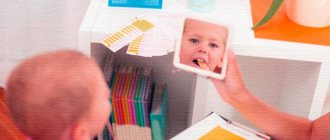Home - About speech therapy - Automation of sound pronunciation - when can you stop practicing?
Our life consists of daily communication. But it happens that a conversation with others causes awkwardness and embarrassment. Most often this happens if there are some defects in your speech (burr, lisp, etc.) that could not be corrected in childhood. Young children can be taken to see a speech therapist, but adults often do not seek help, thinking that it is too late. However, this is not at all true. Let's figure out how a speech therapist can help, what stages children and adults need to go through on the way to beautiful speech.
Speech therapist
is a specialist in the correction of oral and written speech.
At the first meeting, the specialist will conduct diagnostics, identify violations, their causes, and talk about plans to correct the defect.
What sound will the speech correction work begin with, and what sound will it end with? During the learning process, the planned route may change taking into account the characteristics and capabilities of your speech apparatus. It’s difficult to say about the exact timing: for some people the sound can be installed in one lesson, for others it takes a month or more.
Traditional work on correcting sound pronunciation consists of four stages:
1) Preparatory work (development of mobility of articulation organs, speech exhalation);
2) Direct sound production;
3) Automation of the delivered sound (fixing the sound in speech from simple to complex);
4) Differentiation of sounds (distinction by ear between sounds that are similar in articulation, mixed sounds. This stage will help to avoid mistakes in writing and dysgraphia in the future).
Let's talk about each stage in more detail.
Preparatory work.
Work on producing sounds begins with articulatory gymnastics. The tongue is a muscle. And this muscle needs to be developed and, most importantly, learned to control it. Certain articulation exercises activate specific areas of the tongue that are involved in the production of sounds. Such gymnastics is useful for children and adults even without speech impairments. It helps to speak more clearly, and elements of such gymnastics are used in public speaking classes. With complex speech disorders (for example, with dysarthia, which has become common lately), some parts of the tongue do not move and are tense, while in other cases they are very relaxed. These features are associated with a violation of muscle innervation; nerve impulses simply do not reach certain areas of the tongue and it becomes very difficult to control the tongue. Of course, this makes it difficult to speak sounds correctly.
At the same stage, work on breathing occurs. We also need it to produce many sounds. So, when pronouncing the sounds [S], [SH], the exhaled air flows through the middle of the tongue, with the sound [R], it “hits” its tip, and with the sound [L], it seems to “bend around” the tongue.
Automation of sounds in children with dysarthria
using tactile-kinesthetic stimulation as a technique that optimizes speech therapy work in the conditions of modern requirements (work experience).
Currently, the number of preschool children with speech disorders is steadily growing. The main contingent of compensatory groups are children with dysarthria (its various forms). Therefore, increasing the effectiveness of correctional and speech therapy work to eliminate speech disorders in preschool children with a clinical diagnosis of “dysarthria” is currently one of the pressing problems of speech therapy.
The leading defect in dysarthria is a violation of the sound pronunciation and prosodic aspects of speech associated with organic damage to the central and peripheral nervous systems. Due to damage to the central nervous system and impaired innervation of the muscles of the speech apparatus, children do not develop the necessary kinesthesia, as a result of which the pronunciation side of speech does not spontaneously improve.
Consequently, automation of sounds has its own characteristics and is quite difficult. It is necessary to take into account the lack of innervation and select exercises that enhance kinesthetic sensations.
In accordance with the FGT to the structure of the basic general education program of preschool education, the content of correctional work involves the use of special teaching aids and didactic materials.
To overcome dysarthria, a complex intervention is required, including medical, psychological, pedagogical and speech therapy. Speech therapy work to overcome dysarthria includes five stages. At each stage, a specific pedagogical task is solved. Let's look at the stages:
Stage 1 – preparatory. The purpose of this stage is to prepare the articulatory apparatus for the formation of articulatory structures. It includes six areas:
- normalization of muscle tone,
- normalization of motor skills of the articulatory apparatus,
- normalization of speech exhalation, development of a smooth, long exhalation,
- normalization of voice, normalization of prosody,
- normalization of fine motor skills of the hands
Stage 2 - development of new pronunciation skills. Let us highlight the directions of this stage:
- development of basic articulation patterns,
— determining the sequence of work on sounds,
- development of phonemic hearing,
- sound production,
— automation,
- differentiation (auditory differentiation; differentiation of articulation of isolated sounds; pronunciation differentiation at the level of syllables, words).
Stage 3 - development of communication skills.
Directions:
1) development of self-control,
2) training correct speech skills in various speech situations,
Stage 4 - overcoming or preventing secondary disorders,
Stage 5 - preparation for school.
Directions:
— formation of graphomotor skills,
- development of coherent speech,
- development of cognitive activity and expansion of the child’s horizons.
The most labor-intensive task for speech therapy practice is the automation of delivered sounds. Therefore, in the search for optimizing methods of correctional work, I set myself a goal: to study and analyze scientific and methodological literature on the topic.
The problem of automation of sounds in dysarthric children was addressed in the studies of E.F. Sobotovich, E.M. Mastyukova, T.B. Filicheva, E.N. Vinarskaya, N.V. Serebryakova and others. They noted that in children with a low level of speech formation, automation is difficult. The authors recommended providing for a gradual and systematic complication of the material, observing a strict sequence when working on sound automation, but did not consider the effect of stimulation of the receptor zones of the hands on articulatory kinesthesia.
Other approaches were noted in the works of I.B. Karelina. She suggests using kinesiotherapy (motion therapy) as an optimizing means of correctional work.
L.V. Lopatina experimentally proved the success of sound automation in dysarthria by forming the kinesthetic and kinetic basis of movements, carrying out kinesthetic analysis and synthesis of manual and articulatory movements, transforming individual motor skills into serially organized movements.
T.V. Sorochinskaya and E.F. Arkhipova supplemented the system of exercises aimed at automating sounds in dysarthria with experimentally proven techniques. In their opinion, optimizing the process of automation of sounds in erased dysarthria is the inclusion of finger exercises performed on objects with a needle-like surface.
The proximity of the cortical zones of innervation of the articulatory apparatus with the zones of innervation of the muscles of the fingers, as well as neurophysiological data on the importance of manipulative activity of the hands for stimulating speech development, determine this approach to correctional work.
All analyzers take part in the speech functional system: auditory, motor, skin-kinesthetic, visual. Each of them contributes to the efferent and afferent bases of speech. The movement of the fingers stimulates the maturation of the central nervous system, and one of the manifestations of this is the improvement of the child’s speech.
In my practice, I decided to use techniques that optimize speech therapy work, including finger exercises on the Kuznetsov applicator, proposed by T.V. Sorochinskaya and a modular sound automation system developed by E.F. Arkhipova and set herself the following tasks:
— study the types of exercises existing in practice with the Kuznetsov applicator (in relation to speech therapy work),
- classify games and exercises,
— check their effectiveness in practice,
— make educational and game aids from applicator modules.
I will present my work experience and reveal the main points.
Automation of the delivered sounds is preceded by clarification of the pronunciation of vowels, because on their basis, it is easier to coordinate the work of all parts of the articulatory apparatus, and it is vowels that provide better speech intelligibility. As a demonstration material, visual supports-symbols were made that not only suggest which vowel sound to pronounce, but also remind that the lips should actively work.
At the preparatory stage, we first teach the child to press the fingertips of both hands separately and sequentially from thumb to little finger while simultaneously clearly pronouncing vowels. (A – thumb, O – index finger, U – middle finger, I – ring finger, Y – little finger, E – whole palm) Then we combine the movements of the fingers and the articulatory apparatus and bring them to automatism. We pronounce vowel sounds with strengthening and weakening of the voice, loudly and quietly.
Next, the accuracy of movements, their rhythm, and smoothness are worked out.
Since the main form of working with children and the leading activity for them is play, I used game material from the applicator modules as a novelty and attractiveness: educational and play aids “Green Meadow” and “Talking Palms”. The game “Choose a Ring” helped to consolidate the meanings of the symbols of vowel sounds.
After mastering the skills of finger movements on the Kuznetsov applicator and clarifying the articulation of vowel sounds, I begin to automate the delivered sound in syllables, words and sentences, maintaining the sequence of finger movements on the applicator. In parallel, work is underway to clarify and develop phonemic hearing and the expressiveness of speech. To automate any delivered sound, I use 11 modules (11 variants of sound combinations) with a gradually more complex structure of phoneme combinations. The content of each module corresponds to a certain stage of automation of the delivered sound.
The sequence of automation of sounds using the educational and game aid “Talking Palms” is presented on the slide. In addition to the manuals, I use pictures or toys - symbols for consonant sounds.
As an example, let's look at some stages (modules) of automation.
First module. A separate pronunciation is expected: S...G (S is a consonant that we automate, G is a vowel). We articulate exaggeratedly at intervals and pronounce for a long time: “S-A, S-O, S-U, S-I, S-Y.” Simultaneously with the pronunciation of vowels, children press the fingers of both hands to the surface of the applicator. We remind you to actively work your lips when pronouncing vowels.
Second module. Direct syllable .
The delivered sound is pronounced together and exaggeratedly in combination with vowels, on syllabic material. A syllable is the simplest unit of speech; it does not carry any meaning, so it is easier to consolidate a new skill.
Sound automation occurs sequentially with all vowels. For example, with the vowel a
– in words containing a direct syllable with and without stress, in phrases and sentences. Finger movements on the applicator are performed by the thumbs of both hands in words with the syllable SA. Then we automate with other vowels.
Third module. Reverse syllable. Placed sounds are articulated with vowels in an exaggerated manner at intervals. The fingers of both hands are alternately pressed against the applicator when pronouncing vowels. Only syllables are practiced.
Fourth module. The delivered sound in the reverse syllable is pronounced together, consistently with all vowels.
Fifth module. Intervocalic position. We pay attention to the switching of articulation from a vowel to a consonant and again to a vowel. We accompany the pronunciation with movements on the applicator.
For the sound S these can be words: WASP, MUSTACHE, WASPES, ASPEN, WANTERS.. For L - SMILE, SNAIL, CATCH...
Then the worked out sound combinations are included in phrases, sentences, and spontaneous speech.
Further along the modules, the complexity of sound combinations increases and the combinations of consonants vary.
Thus, pronouncing a vowel with any automated sound is accompanied by pressing the fingertips against the applicator.
In the motor and sensory projections of the cerebral cortex, the zones of the fingers and the articulatory apparatus occupy a significant place and are located nearby.
Exaggerated articulation of vowels and consonants contributes to the supply of clearer kinesthesia to the cerebral cortex, and movements of the fingers reinforce motor images of sounds, bringing most of the cortex into an excited state, which contributes to their memorization and subsequent reproduction.
By automating sounds, we work on the syllabic structure of the word and the grammatical structure of speech.
Using this model of sound automation in combination with tactile-kinesthetic stimulation of the hands of both hands, the following games and exercises can be included in the structure of speech therapy classes: for the development of speech breathing and voice (“Echo”, “Blizzard”, “Ladder”, “Singing Fingers” ); to automate sounds (“Friendly sounds”, “Pick up and name”, “Give me a word”, “Repeat after me”, “Magic words”, “Fun cube”); on the formation of the syllabic structure, the grammatical structure of speech: (“Finish the word”, “Count - ka”, “Say one syllable more (less)”, “Name it affectionately”).
Working with the aids from the applicator, children get the opportunity to use three sensory channels: kinesthetic, visual, auditory; those. there is an expedient merging of visibility and practical actions (and this is where their innovativeness lies.)
The aids used are multifunctional: with their help, in the optimal time frame, you can automate and differentiate any sound (vowel, consonant).
They individualize the correction process: they allow taking into account the individual characteristics of the child.
Available: translate a didactic situation into a game plan.
Variable: they allow for unobtrusive repetition and consolidation of the necessary skills.
Compact: almost all the necessary base is collected in one place.
The novelty of the material (applicator modules) ensures cognitive activity and interest of children.
Training the organs of articulation to switch from one articulation to another, carried out at an exaggerated and moderate pace, gradually becoming more complex (modules), creates strong kinesthetic and proprioceptive sensations. As a result of working with children:
- a stereotype of new clear articles is formed, diction improves;
— reduced pronunciation of vowels is eliminated;
- phonemic perception develops;
— the syllabic structure of the word is improved.
This training helps to prevent dysgraphic errors in writing in children with dysarthria. This concerns motor dysgraphia, which is based on the immaturity of kinesthetic images of sounds.
The practical application of tactile-kinesthetic stimulation at the stage of sound automation speeds up the process of sound automation and significantly improves the quality of speech.
Sound production.
When the preparatory work has been completed, the speech therapist begins sound production. That is, it tries to evoke the correct sound. There are different options for how to do this: by imitation, when a person repeats after a speech therapist, mechanically with the help of special speech therapy probes, from reference sounds, etc. How quickly the sound rises depends on the readiness of the articulatory apparatus: on the person’s ability to control his tongue and lips. The skill of speech exhalation is important. Sometimes the sound is staged in one lesson, in other cases it takes more time and the use of different production methods.




